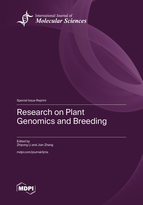Research on Plant Genomics and Breeding
A special issue of International Journal of Molecular Sciences (ISSN 1422-0067). This special issue belongs to the section "Molecular Plant Sciences".
Deadline for manuscript submissions: closed (31 August 2023) | Viewed by 34896
Special Issue Editors
Interests: plant genomics and genetics; molecular breeding; plant physiology; carbon partitioning; seed development
Special Issues, Collections and Topics in MDPI journals
Interests: plant genetics; molecular biology; biochemistry; transcriptome; proteome approaches; synthetic biology
Special Issues, Collections and Topics in MDPI journals
Special Issue Information
Dear Colleagues,
Over recent decades, crop breeding has greatly benefited from the knowledge of plant genomics and genetics, as well as the development of modern biotechnologies. It is imperative to explore the genetic basis and molecular mechanisms underlying various plant developmental and growth processes, as it underpins crop yield, grain quality, and stress adaptions. The goal of this Special Issue, “Research on Plant Genomics and Breeding”, in IJMS is to present an overview of the latest fundamental discoveries in the field of plant genomics, as well as the potential utilization of biotechnologies in crop genetic improvement. We welcome all types of submissions, including original research, reviews, methodologies, mini reviews, perspectives, and opinion articles in this field, including (but not limited to) research covering:
- Genetic and functional characterization of genes regulating important plant development processes or agronomic traits;
- Genetic improvement in crops using gene editing and other modern biotechnologies;
- Discovery, characterization, and application of germplasm resources with elite traits.
Dr. Zhiyong Li
Dr. Jian Zhang
Guest Editors
Manuscript Submission Information
Manuscripts should be submitted online at www.mdpi.com by registering and logging in to this website. Once you are registered, click here to go to the submission form. Manuscripts can be submitted until the deadline. All submissions that pass pre-check are peer-reviewed. Accepted papers will be published continuously in the journal (as soon as accepted) and will be listed together on the special issue website. Research articles, review articles as well as short communications are invited. For planned papers, a title and short abstract (about 100 words) can be sent to the Editorial Office for announcement on this website.
Submitted manuscripts should not have been published previously, nor be under consideration for publication elsewhere (except conference proceedings papers). All manuscripts are thoroughly refereed through a single-blind peer-review process. A guide for authors and other relevant information for submission of manuscripts is available on the Instructions for Authors page. International Journal of Molecular Sciences is an international peer-reviewed open access semimonthly journal published by MDPI.
Please visit the Instructions for Authors page before submitting a manuscript. There is an Article Processing Charge (APC) for publication in this open access journal. For details about the APC please see here. Submitted papers should be well formatted and use good English. Authors may use MDPI's English editing service prior to publication or during author revisions.
Keywords
- gene cloning and function
- genetic engineering
- molecular genetics
- genome editing
- regulatory mechanisms
- germplasm enhancement
- molecular breeding and marker-assisted selection








